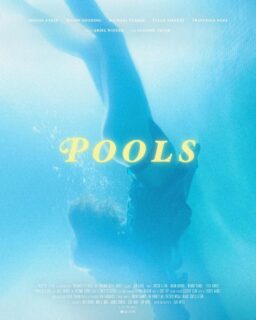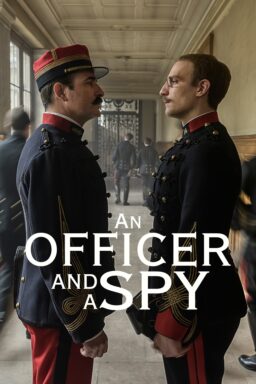
Shot #1 (of this clip — not of the entire sequence). A fairly conventional shot establishing the red car on the left gaining on the orange one on the right. I’d say these shots look a lot cooler on the page (and probably on the computer storyboards) than they do in “action.”

Shot #2. Red car driver (Taejo) pulls up alongside Snake Oiler (not that their identities are clear from the movie itself).

Shot #3. Back to two-shot.
There’s no action
No no no there’s no action
— Elvis Costello, 1978
When I was four years old I went to the 1962 Seattle World’s Fair — the one where Elvis and Joan O’Brien were, according to the ads, seen “swinging higher than the Space Needle” in “It Happened at the World’s Fair” (Norman Taurog, 1963). There was a roller coaster called the Wild Mouse, but I was too afraid to ride on it. I did, however, like The Scrambler, which whirled you around in a logical geometrical pattern (although it felt pretty wild when you were on it) that looked really cool when seen from directly overhead, up on the observation deck of the Space Needle. (For years I had nightmares about falling off of the Needle, and if I’d ever hit the ground I would like to think I would have been extra-scrambled by the Scrambler.)

Shot #3 (continued). “Camera” zips (the terms “zoom” or “dolly” don’t really apply) in on orange car and device emerges from under hood, pointing toward red car (out of frame, left).

Shot #4. Close up of Racer X. Where is Racer X in relationship to what we’ve just seen?
Another thing I loved about the World’s Fair was this arcade stand where you could make your own art by squirting plastic bottles of different colored paints onto a spinning piece of paper. These were “motion paintings” (and could be quite psychedelic, although we didn’t know that term in 1962), and although they were just a blur when you were making them, when the machine stopped spinning they looked like an explosion of colors. I had several spin paintings tacked up on my bedroom wall.
The joy, the thrill, I got from both these things — the ride and the art — had to do with color and the sensation of movement. No wonder I like movies so much. Even today, put me in front of a lava lamp, or a fully decked-out Christmas tree, and I’m mesmerized. But the motion on a two-dimensional plane is perceptually different than movement through three-dimensional space (or, at least, the illusion of it), and that’s what I want to take a gander at here.

Shot #5. Close on gloved hand shifting gears. We assume this is related to the previous close up and therefore still Racer X.

Shot #6. A yellow and black car accelerates. Because we know from previous scenes that Racer X drives a yellow and black car, we’ve probably recognized that this is his vehicle. But, again, where is he in the pack?

Shot #6 (continued). Camera pans 180 degrees to follow Racer X’s car as it goes by. You may or may glimpse the red car on the right, but you can spot it in this freeze-frame. One of the few shots that doesn’t rely on a flat, trompe l’oeil motion effect.

Shot #7. Close up of yellow bumper contacting another bumper and pushing it up (right).
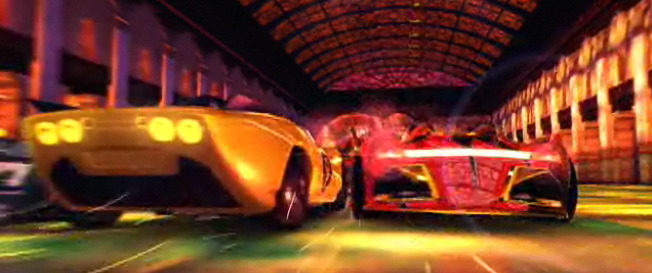
Shot #8. Return to angle from shot #6. Because the motion is away from the traveling “camera,” we assume these are the rear ends of the vehicles. Rear-ended car is not seen.
I feel about your average modern shootout/ chase/ race sequence the way Harry Moseby (Gene Hackman in Arthur Penn’s 1975 masterpiece “Night Moves“) feels about the work of a certain Gallic auteur: “I saw a Rohmer film once. It was kind of like watching paint dry.” Leave aside, for the moment, that an Eric Rohmer movie is action-packed… because that’s another story.
Steven Spielberg put his finger on it in an interview with VanityFair.com in February, 2008, which was quoted by Benjamin Wright in a fine aspect ratio post called “Cutting for clarity.” Of constructing action sequences, Spielberg said:
I go for geography. I want the audience to know not only which side the good guy’s on and the bad guy’s on, but which side of the screen they’re in, and I want the audience to be able to edit as quickly as they want in a shot that I am loath to cut away from. And that’s been my style with all four of these Indiana Jones pictures. Quick-cutting is very effective in some movies, like the Bourne pictures, but you sacrifice geography when you go for quick-cutting. Which is fine, because audiences get a huge adrenaline rush from a cut every second and a half on “The Bourne Ultimatum,” and there’s just enough geography for the audience never to be lost, especially in the last Bourne film, which I thought was the best of the three. But, by the same token, Indy is a little more old-fashioned than the modern-day action adventure.

Shot #9. Reverse angle to front of vehicles again. Orange car on right shoots green splooge.

Shot #10. Anonymous blue driver gets slimed.

Shot #11. Return to previous angle of shot #9.

Shot #11 (continued). Blue car flips.

Shot #12. Reverse angle. Red and black car rapidly approaches airborne blue car, now sideways.
Wright elaborates:
In the above quotation, Spielberg is discussing two elements of visual style. His preference for clearly defined spatial geography is not unlike many other contemporary filmmakers, who build scenes out of stable blocks of shots: master (establishing shot), medium, and close up. You establish the space with a wide or long shot, then move in for greater details and drama once direction and “geography” has been defined. David Fincher comes to mind, so does Paul Thomas Anderson, the Coen brothers, and Michael Mann. However, more and more films — including the Bourne series — sacrifice visual clarity for kinetic rhythm and movement.
I look at it kind of like this: Spielberg is the Scrambler and the Wachowski Brothers of “The Matrix” and “Speed Racer” are the swirly painting.
In his New York Times review of “Speed Racer,” A.O. Scott wrote: “When it comes to storytelling, “Speed Racer” has nothing in common with its title…. [It] is about a boy driving a car, surely a subject that cries out for linearity, simplicity, velocity.” Is there some subversive reason that the Wachowski’s should wish to negate the concepts of “speed” (rapid acceleration through three-dimensional space) and “racing” (the relative physical positions of two or more entities moving, more or less in parallel, along a course)? Was the concept was to suggest the flattened animation of the TV show? Why is the most dizzying (and charming) use of CGI — and the strongest sensation of actually hurtling through space — contained in a single 360-degree shot of wee Speed sitting in a classroom and fantasizing about racing at the beginning of the picture?
Look over the 25 frame grabs here, taken from 19 seconds of “Speed Racer.” Most of them represent shots of one second or less, though two or three last up to three seconds. “Camera movements” are indicated in the captions. The Wachowskis aren’t doing anything new (here or in the CGI-enhanced parallel-action-across-time sequences), but they’re mixing traditional Hollywood cutting with some peculiar and confusing choices. Dig it or don’t (I don’t), but I’d argue that the movie sacrifices visual clarity and fails to create a sense of kinetic rhythm and movement. It just spins its color-wheels.

Shot #13. Driver in white swerves (ostensibly to avoid flying sideways blue car).

Shot #14. Cut back to wider shot. Same angle of shot #12. Blue car provides visual point of reference. Red car (with driver from previous shot) on the left. Orange car on right. Still no sign of Racer X.
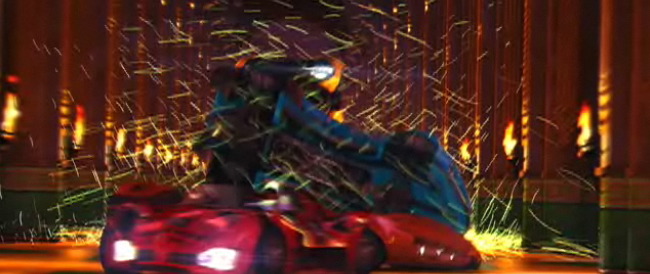
Shot #14 (continued). Blue car appears to land on orange car, as yellow car (Racer X!) jumps over all. Snake Oiler vanishes almost before we can register that he’s gone.

Shot #14 (continued). Red car swerves across frame from left to right. Yellow car continues leap.

Shot #15. From back in the pack. White car now approaches still-sideways blue car.
Even in a video game, more of an influence on the movie’s aesthetic than the anime TV show, it’s essential that you know where your avatar is in the world on the screen at all times. How else can you hunt, or fight, or flee, or win? In a dimension where there are no rules or limitations, where anything is as likely to happen as anything else… then what matters? The “Speed Racer” drivers could use GPS systems.
I know “Speed Racer” was a flop and it is not my intention to pick on it just because it failed. I did that before. (Not much, after a charming ADD opening sequence in a classroom/principal’s office, which you can see for yourself here, under “First Seven Minutes,” which goes on about four too long. First words spoken by an on-screen character: “Distracted?”)
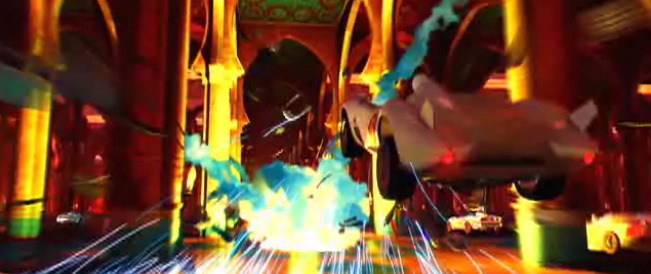
Shot #15 (continued). Blue car explodes and white car jumps into the air…

Shot #15 (continued). … and sails over it.

Shot #16. Reverse angle. White car + M on helmet = Speed. We don’t really have time to ask how he wound up so far behind his pals.

Shot #17. Close on gear shift.

Shot #18. Close on boot, accelerator.

Shot #19. Smoke and stuff emerges from the loooooong mosque-like structure through which the cars have evidently been racing. Note camel or llama or whatever it is on the left.
I’m much more interested in how the movie is put together. Keep in mind, this is just a snippet from the last of several elaborate “race” sequences in the 135-minute film, though it’s fairly representative of the movie as a whole. You can see more of this sequence and the one before it here, or the first 54 seconds of it here, under the clip title “Squealing Tires.” (If you choose the former, note the old-fashioned horizontal wipe transitions, covered by close-ups of the actors — a technique used repeatedly.) Even when you stop-frame it like this, the grammar (while not unfamiliar) isn’t quite coherent. Nor does it strike me as particularly innovative or interesting, and after a short while I found it all numbing. It’s a long and exceedingly busy movie, but as I said in my review, it felt to me like it was all movement and no momentum. Kind of iike visual white noise — or like a spin-painting when it’s still spinning so fast that all the colors blend to gray…







